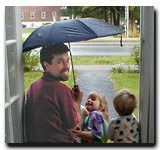May's Sustainable Living Tip
Be prepared. Create an emergency kit, make a plan, and stay informed. Start with a short-term plan for yourself and your family, but don't stop there. What is the long-term plan for your community and our society to avoid unnecessary emergencies and survive unavoidable ones?
Facts about Emergency Preparedness
- The US Department of Homeland Security asks you to be prepared to survive on your own for three days in the event of a serious emergency.
- You can find a list of supplies to include in your basic emergency kit at www.ready.gov.
- One of the most important items to have on hand is at least three gallons of clean, drinkable water per person in your family.
- If you would like a free, 5 gallon HDPE #2 plastic container with a handle and spigot, please call us at 729-4050 or email us at newsletter@fwhorch.com to arrange for pick up at our store. We have empty containers that held non-toxic, plant-based dish and laundry soap from Earth Friendly Products. When thoroughly rinsed and filled with tap water from a municipal supply, these containers are suitable for storing water for emergency use. If you use well water, most authorities recommend adding two drops of liquid chlorine bleach to help prevent microbial contamination.
- Your kit should also contain non-perishable food, a first aid kit, and a wrench or pliers to turn off utilities.
- For dependable light, you may want a shake flashlight that is water proof and does not require batteries.
- To hear emergency broadcasts and weather reports, you may want a hand crank radio.
- Beyond the basics, you should prepare a list of essential items, like prescription medicines or eye glasses, that are unique to your needs.
- Along with your kit, make a plan of what to do during an emergency. Identify an out-of-town contact that all members of your family can call in case you become separated. Decide on a meeting place if you need to leave your home.
- Once you've assembled your emergency kit and have a short-term emergency plan, think about ways you can help avoid unnecessary emergencies in your home, community and the world.
- Minimize localized flooding by installing rain barrels and rain gardens to divert water from storm drains. This also helps prevent pollution from being washed into our lakes and streams.
- Ensure greater food security by planting a row for the hungry in your home garden. Vegetables with good storage life are best, such as beets, cabbage, carrots, turnips, and winter squash.
- Help avoid power outages by reducing your electricity consumption. During times of high demand, avoid running your electric clothes dryer (use a drying rack instead), toaster, air conditioner or space heaters.
- Prevent frozen pipes in your home by insulating pipes near exterior walls, or by moving plumbing runs to central locations during a renovation. Remember, your home freezes from the top down and from the outside in. Pay particular attention to sealing leaks that may allow cold air to circulate around a pipe.
- Consider installing a solar space heater for emergency or unattended heat. Solar space heaters require no fuel or electricity, just sunlight to help maintain warm indoor temperatures in homes, schools and businesses that are well insulated. They can be installed on a south-facing wall or a roof.
- Make a long-term plan to transition away from fossil fuels. Coal, oil and gas are already unnecessary for home heating; you can heat with solar, wood or electricity instead. Save up for a plug-in electric car, which you likely will be able to buy here in the United States by 2012.
- According to the Energy Information Administration, Maine, along with much of the U.S. Northeast, is vulnerable to distillate fuel oil shortages and price spikes during winter months. Maine’s per capita petroleum consumption is high due to the widespread use of fuel oil for home heating during the long, cold winters. About four-fifths of Maine households use fuel oil as their primary energy source for home heating, a higher share than in any other State.
- In July 2000 the President directed the U.S. Department of Energy to establish the Northeast Heating Oil Reserve. The Reserve gives Northeast consumers adequate supplies for about 10 days, the time required for ships to carry heating oil from the Gulf of Mexico to New York Harbor. The Reserve's storage terminals are located in Perth Amboy, New Jersey, and Groton and New Haven, Connecticut.
- Maine has no fossil fuel reserves but has substantial renewable energy potential. Maine generates a larger share of its electricity from nonhydroelectric renewable resources than any other State.
- Renewable sources, mainly wood and wood waste and hydroelectric, account for almost half of Maine’s net electricity generation. Maine’s residential electricity use is low compared with the rest of the Nation, in part because demand for air-conditioning is low during the cool summer months and because few households use electricity as their primary energy source for home heating.
- If we start harnessing clean renewable energy for our needs, maybe future headlines about offshore disasters would read like this one posted in jest online: "Large Air Spill at Offshore Wind Farm. No Loss of Life or Environmental Threats Reported. Some Claim to Enjoy the Extra Breeze."


No comments:
Post a Comment